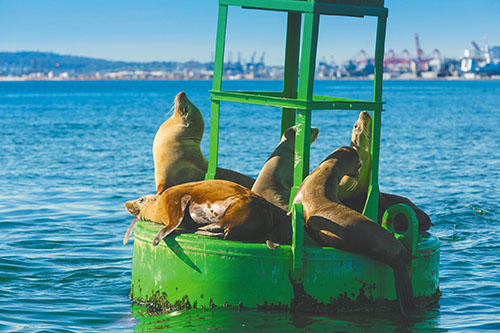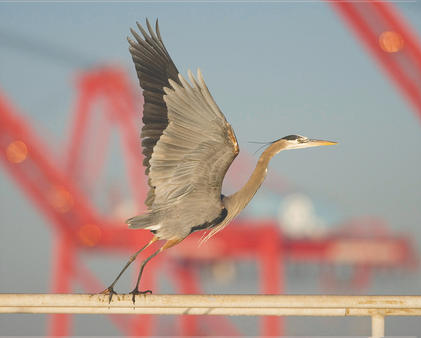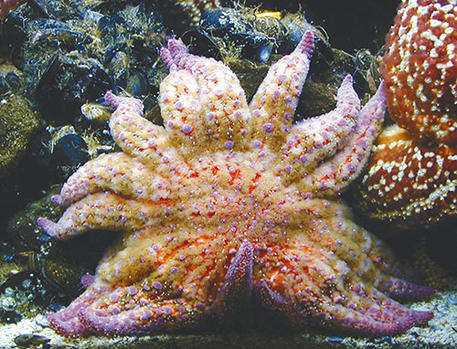In the 1970s, the inner harbor of the San Pedro Bay port complex was so inhospitable to life forms that, upon entering these waters, fishermen would find that the barnacles clinging to their boats had fallen off.
That’s how Dan Salas, who has been working in the harbor since he was a boy in the 1970s, recalls it. But by 2000, things had improved enough that Salas started Harbor Breeze Cruises, a company offering cruises for watching sea life within and outside of the breakwater. Now – thanks to the efforts of the ports of Long Beach and Los Angeles, cities up the Los Angeles River and other entities – waters in the San Pedro Bay are clean and full of life, and as a result, Salas’s business is reaping the benefits.

California sea lions are the most abundant type of marine mammal living in the ports’ harbor. (Port of Long Beach photograph)
“Now it is fantastic,” Salas said of the water quality and marine life in the San Pedro Bay harbor. “We see bottlenose dolphins occasionally coming inside of Rainbow Harbor now. We see sea lions all the time and even a grey whale occasionally coming in the harbor and feeding.”
The recently released results of the ports’ joint Biological Harbor Survey, which measures the quantity and types of marine life in and around harbor waters, support Salas’s conclusions. The survey, which requires meticulous field observations of marine life in the harbor, was conducted from 2013 to 2014, and port staff and contractors have spent the past few years analyzing the results and preparing a written report.
Measurements of dissolved oxygen, which is necessary for all marine life to thrive, and phytoplankton, an indicator of water quality and source of food for many marine animals, were higher than ever before, according to an announcement from the Port of Long Beach.
The survey identified 558 species of plants and animals living on rocks and pilings within the harbor complex – a 60% increase from the last survey conducted in 2008 and close to two times as many species catalogued in 2000. According to the survey report, on average there are more than 46,000 plants and animals on a square meter of rocky shoreline within the harbor.
Giant kelp is also thriving. In 2014, giant kelp beds spanned 132 acres of outer harbor waters. In 2008, they only encompassed 80 acres, according to the Port of Long Beach. Kelp beds shrink when water warms in the summer. Unusually warm water temperatures in the summer of 2014 likely caused kelp beds to shrink to 46 acres, less than the 52 acres observed in 2008.
Other findings from the study:
• Nearly 750,000 pelagic (open water) fish belonging to 35 different species were collected (and released) during the survey.
• 90% of these fish were anchovies.
• Nearly 20,000 bottom-dwelling fish representing 58 species were collected, with white croaker and queenfish among the most abundant species.
• More than 76,000 birds belonging to 96 species were observed in the harbor.
• California sea lions were noted as the most abundant type of marine mammal in the harbor.
• Less than 10% of all species catalogued were non-native, or introduced, species and do not appear to be taking over their habitats.
The ports attribute the positive findings to continued reduction of environmental impacts of port operations due to policies like the Clean Water Act of 1972 and the ports’ joint Water Resources Action Plan (WRAP), a document outlining programs and procedures for maintaining good water quality in the harbor.
These policies require controls to reduce litter and stormwater runoff, as well as water quality monitoring both for general maintenance and during construction projects, according to Justin Luedy, an environmental specialist for the Port of Long Beach who serves as POLB’s project manager for the biological diversity survey.

A heron flies through the ports of Los Angeles and Long Beach. (Port of Long Beach photograph)
Prior to the Clean Water Act, there was little to no regulation of water quality, Luedy said. The port is more than 100 years old, and for about half a century, it operated without water quality standards in place, he noted. “I would say our worst [tested] water quality occurred in the ’70s and into the ’80s. And even before that, certainly,” Luedy said.
In the 1960s, the amount of dissolved oxygen in the inner harbor was very low, according to Kathryn Curtis, who oversees the water resources group of the Port of Los Angeles’s environmental division. “Now the dissolved oxygen is at optimum levels throughout the entire harbor,” she said. “We have a thriving biological community, and that wouldn’t exist with poor water quality.”
When Salas was a 12-year-old working on commercial sport-fishing boats in the harbor, the situation was very different. “Back when I was first starting out in the harbor, we would fish all day long, and we would never catch anything,” he recalled. “We’d never see a dolphin in the harbor. Occasionally, we might see a sea lion, but it was rare. . . . There wasn’t much kelp back then. There wasn’t a lot of stuff growing on the rocks.”
In the 1970s, water quality in the harbor was clearly poor, according to Salas. “Back then, I would watch fisherman pump oil into the water,” he recalled. “There weren’t a lot of regulations. You could come down to the docks in the morning and smell diesel.” Now there are strict regulations in place preventing ships and boats from releasing chemicals and waste into the water, he pointed out.

The ports’ most recent biological diversity survey revealed a 60% increase of plants and animals, like this sea star, living on rocks and pilings with the harbor complex. (Port of Long Beach photograph)
Stormwater management has been key in improving water quality at the ports, according to Luedy. This program requires tenants to prevent pollutants from entering any stormwater runoff from their sites and to monitor that runoff. Stormwater runoff management also applies to the ports’ construction projects, such as the Gerald Desmond Bridge Replacement Project and the Middle Harbor Redevelopment Project, he noted.
“We assist and inform our tenants of the appropriate best management practices they should be using,” Curtis said. “We are very proud of the fact that it has made a significant and noticeable change in the water quality over the years.”
Because the harbor is at the mouth of the Los Angeles River, stormwater runoff that flows downstream from other cities remains a problem, Luedy explained. “It’s always going to be an issue, but even those cities and communities are so much better now than they used to be. And there is so much more regulation in place,” Luedy said.
The sediment at the bottom of the harbor waters still holds legacy contaminants from the ports’ historical operations, according to Luedy. However, these contaminants are not considered a major threat or hazardous. Survey results indicated healthy conditions of water and sediment quality throughout the harbor.
While Curtis said there “is always room for improvement,” it is her opinion that the water quality within the harbor is among the best in the world, considering the industrial operations of the ports.
“We’re environmental stewards,” Luedy said. “We have a responsibility to maintain and better our water quality while we grow.”
